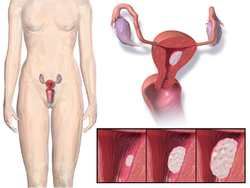Non-surgical treatment of malignant gynecological tumors
Non-surgical treatment of malignant gynecological tumors[1] includes three modalities: radiotherapy, chemotherapy and hormone therapy.
Radiotherapy[edit | edit source]
In cervical carcinoma, surgical treatment is primarily indicated in the early stages, although a separate radiotherapy with curative intent can be used instead of Wertheim's radical hysterectomy. It has a comparable median survival, but it has more frequent late complications, so it is used more in cases of contraindications to surgical treatment[1]. A combination of brachytherapy and teletherapy is used, sometimes with concomitant chemoradiotherapy. In later stages (spread outside the cervix), palliative teleradiotherapy is primarily indicated.
Brachyradiotherapy is used for cervical cancer.
Brachyradiotherapy[edit | edit source]
For cervical cancer, a uterovaginal applicator with an after-loading system is used[1]. A Y-probe is used for endometrial cancer.
137Cs or 192Ir[1] are used as emitters.
Teleradiotherapy[edit | edit source]
The radiation source is a linear accelerator or betatron[1]. For cervical cancer, a total dose of 50 Gy at 2 Gy/day is used[1]. Sometimes concomitantly small doses of cis-platinum[1] are used.
Concomitant chemoradiotherapy[edit | edit source]
The purpose of concomitant chemoradiotherapy is to increase the sensitivity of tumor cells to ionizing radiation. Administered chemotherapy by itself does not have cytostatic effects[1] in these small doses.
Chemotherapy[edit | edit source]
It is used either concomitantly for cervical cancer, palliatively for stage IVB, and in some indications it can also be used neoadjuvant[1]. Cis-platin is used intraperitoneally (IP).
For endometrial cancer, the PTX-CBDCA (paclitaxel and carboplatin) scheme is used[1].
In ovarian cancer, chemotherapy is used either as interval debulking surgery with 3 cycles neoadjuvant, or 6 cycles after 21 days adjuvant. The standard is paclitaxel with carboplatin[1].
Hormonal therapy[edit | edit source]
Hormonal therapy is used for endometrial cancer and lung metastases. A high dose of gestagens, antiestrogens and aromatase inhibitors[1] is used.
Links[edit | edit source]
Related Articles[edit | edit source]
- Malignant tumors in gynecology
- Surgical treatment of malignant gynecological tumors
- Malignant tumors of the cervix
- Malignant tumors of the uterine body
- Ovarian tumors
External links[edit | edit source]
- www.onkogyn.cz (e.g. the current TNM classification, it is the website of the VFN Oncogynecological Center)



